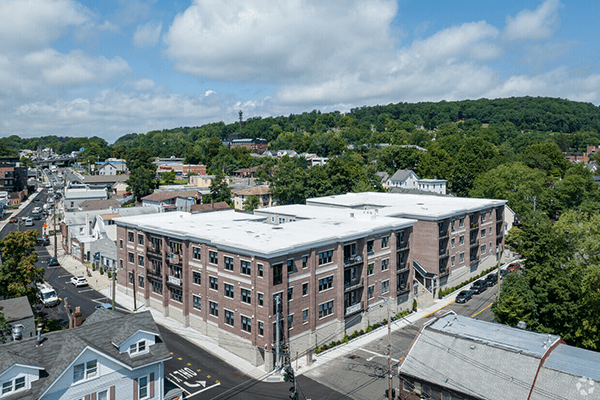|
RCBJ-Audible (Listen For Free)
|
Board Trustees Agree To Re-Examine Zoning Code As Nyack Continues 21st Century Expansion But Stops Short At Agreeing To A Moratorium
By Tina Traster
A village, any village, is like a living, breathing organism that needs to evolve and grow. How it does that depends upon what a municipality attracts and what it thwarts.
This existential question has been raised anew in the Village of Nyack several years after 140 housing units have been added to Upper Main Street and permits have lapsed on a proposed waterfront development that prompted a zone change in the waterfront district.
“I don’t see a moratorium, but I can see a review of the codes,” said Trustee Pascale Jean-Gilles.
Newly elected Village Board trustee Joe Carlin made a name for himself in 2017 when he and others led a movement against the proposed TZ Vista project, later renamed the Gedney Street Project and then Tidewater. The plan called for a 128-unit condo complex in three multi-story buildings on one of the last vacant waterfront parcels.
Last week in a Nyack Village Board workshop, Carlin asked the board to consider a six-month moratorium on new multi-family development village-wide and to rescind waterfront zoning amendments adopted in 2016 in conjunction with the TZ Vista project and revert to prior zoning rules.
After a brief discussion, board members agreed to analyze both the waterfront zoning and development on Upper Main but did not agree to move forward to vote to impose a moratorium on development. Enforcing a building moratorium may give a village time to “pause,” as Carlin hopes to do, but it also sends a message to property owners and prospective developers that additional housing projects are unwanted in the village. It raises the question of whether it’s prudent to put a village’s development community “on ice” at a time when there is a severe shortage of housing, particularly for millennials and empty nesters.
“I don’t see a moratorium, but I can see a review of the codes,” said Trustee Pascale Jean-Gilles.
Since 2018, four housing projects totaling 140 units have been added to Upper Main Street between Midland Avenue and 9W: Nyack Point at 263 Main Street, a former bowling alley, added 33 affordable units; Gateway Lofts at 273 Main Street has 33 units; Diana Place at 249 Main Street added 26 units. The Montclare, at 6 North Midland Avenue, brought on 48 units.
The Pavion, a 135-unit apartment complex at 66 Cedar Hill Avenue, kicked off the new housing boom in 2017.
Market rate units in the new buildings rent for between $2,000 and $4,000 monthly for one and two-bedroom units. For example, Montclare rents range from $2,775 to $4,500, according to apartments.com.
Mayor Joe Rand at the workshop meeting said he was not in favor of a moratorium but added, “I’m willing to look at the zoning codes.”
Some view the handful of new buildings on Upper Main Street to be an eyesore, unfitting in the Victorian village. However, this gateway zone (known as the DMU-2) that flows east from Route 59, is riddled with degraded buildings and old factories that undermine the character and charm of Nyack.
Mayor Joe Rand said he was not in favor of a moratorium but added, “I’m willing to look at the zoning codes.”
In 2016, Nyack adopted an updated Comprehensive Plan that called for an increase in housing opportunities “that respond to Nyack’s changing population, including seniors and young adults.” The plan cites the housing shortage in Nyack for affordable rental units that are walking distance from downtown shops and mass transit stops. The Comprehensive Plan also calls for increased walkability. The plan focused on housing in Nyack’s gateway. A former official had said, “This housing boom that’s in the works will replace many dilapidated, falling-down buildings and old factories.”
Many agree Nyack needs more affordable housing. All of Nyack Point’s rental units in the three-story building, developed by Rockland Housing Action Coalition Project, are affordable. Each of the other three Upper Main developments required a 10 percent allocation, adding nine units in total.
The Village in 2023 adopted a resolution doubling the amount that developers would have to pay to opt out of the affordable unit requirement to $100,000 per unit. Carlin suggested doing away with the opt out. Also, the village lowered its affordable set-aside from 20 percent to 10 percent sometime before, another issue board members want to revisit.
Village leaders are at a juncture, having to weigh the benefits of adding population, which boosts the business community, while preserving the village’s character and quality of life. This can be like a Rubik’s cube puzzle because with every turn, planners and policy makers must calculate future gains and losses while complying with the existing Comprehensive Plan. The village’s population has remained stagnant for six decades. Merchants, and especially restaurants, need younger generations to sustain the workforce. Older people downsizing can’t stay in the village unless there are suitable housing options. When they leave, it drains away people who’ve been loyal to businesses and services over years or decades.
Growing a village calls for a delicate dance between progress and preservation.
The Comprehensive Plan says: “Create an economically sustainable and resilient community capable of balancing the socially and environmentally interdependent needs in a lasting way.” It also calls for protecting and enhancing historic and residential neighborhoods, facilitating revitalization of the downtown, waterfront, and gateway areas.
In 2017, after months of debate and professional consultation, the Village Board, then led by Mayor Jen Laird White, amended the waterfront district to allow a developer additional density in exchange for public amenities, including a riverfront walkway.
The TZ Vista project was proposed on a 3.8-acre former brownfield site at 55 Gedney Street bordering the Hudson River. The site was home to Nyack Gaslight & Fuel and then Con Edison from 1859 to 1965. During this time, carcinogenic coal tar seeped into the soil and water. O&R cleaned the site between 2005 and 2015. It was bought by a partnership of Helmer Construction and DCAK-MSA, an architectural firm.
The amendment largely kept the previous zoning regulations in place, but allowed for additional height and density, while capping the number of apartment units at 35 per acre. With incentives, building heights could reach as high as 52 feet.
To secure additional height and density, a developer would be required to include some of the following amenities into its project: public parkland, underground parking, public access to the waterfront, a pedestrian walkway, a water amenity such as a kayak launch, additional viewing corridors, additional setbacks, and designs that maintain the feel of the village’s downtown buildings.
The amendment also regulated minimum viewing corridors and set limits on the overall width of the buildings should a developer seek additional density. The amendment was a balance of bonuses, protections, and public amenities.
“After seven years [without development] I think we should consider going back to the original code,” said Carlin.
















